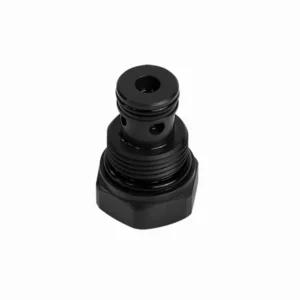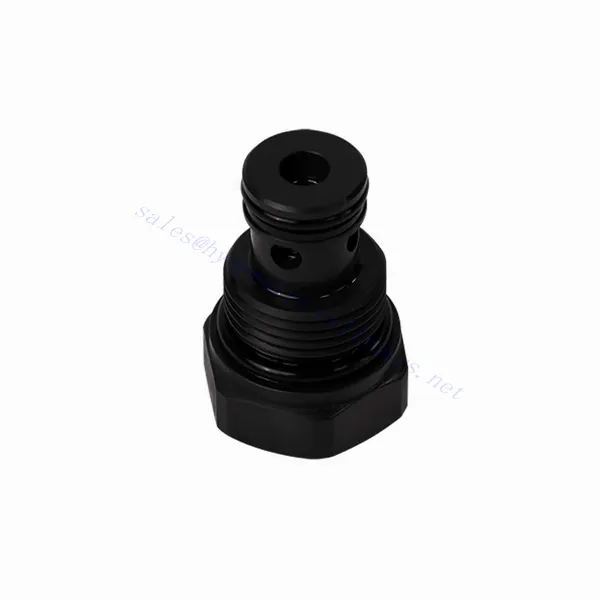RVM Series Check Hydraulic Valve Cartridge
Jako jeden z producentów, dostawców i eksporterów produktów mechanicznych, oferujemy cylindry hydrauliczne i wiele innych produktów.
Prosimy o kontakt w celu uzyskania szczegółowych informacji.
Poczta:sales@hydraulic-cylinders.net
Producent dostawca eksporter siłowników hydraulicznych.
RVM Series Check Hydraulic Valve Cartridge

The RVM series check hydraulic valve cartridge is a reliable and versatile component for optimal fluid control in hydraulic systems. Engineered to ensure efficient and precise regulation of hydraulic flow, this valve cartridge offers exceptional performance, durability, and ease of use.
The RVM series check hydraulic valve cartridge is a reliable and efficient solution for fluid control in hydraulic systems. With its efficient check valve functionality, robust construction, compact design, and high flow capacity, this valve cartridge ensures optimal performance and minimizes the risk of system damage. By following the recommended usage methods and maintenance practices, the RVM series check hydraulic valve cartridge delivers reliable operation and extends the lifespan of hydraulic systems. Upgrade your hydraulic system with the RVM series check hydraulic valve cartridge and experience enhanced fluid control efficiency.
RVM Series Check Hydraulic Valve Cartridge Key Characteristics:
- Efficient Check Valve Functionality:
- The RVM series valve cartridge incorporates a highly efficient check valve mechanism that enables the unidirectional flow of hydraulic fluid.
- It effectively prevents backflow, ensuring smooth operation and minimizing the risk of damage to the hydraulic system.
- Robust Construction:
- Built with high-quality materials, the RVM series valve cartridge is exceptionally durable and resistant to wear, ensuring a long service life.
- Its robust construction enables it to withstand high-pressure environments and demanding operating conditions.
- Compact and Versatile Design:
- The valve cartridge is compact, making it suitable for applications with limited space or weight constraints.
- Its versatile design allows for easy integration into various hydraulic systems, including industrial machinery, mobile equipment, and power units.
- High Flow Capacity:
- Despite its compact size, the RVM series valve cartridge offers high flow capacity, allowing for efficient fluid transfer and optimal system performance.
- It minimizes pressure drops, delivering maximum hydraulic power to actuators and other components.
RVM Series Check Hydraulic Valve Cartridge Parameter:
| Weight | kg | 0.12 |
| Max. operating pressure | bar | 350 |
| Crack pressure | bar | 0.2 0.5 |
| Max. flow-rate | L/min | 30 |
| Viscosity range | mm2/s | Recommandation 30~80, permission 20~380 |
| Fluid temperature range | ℃ | -30 to +80(NBR seal) |
| -20 to +80(FKM seal) | ||
| Fluid | Mineral oil suitable for NBR and FKM seal | |
| Phosphate ester for FKM seal | ||
| Degree of contamination | Maximum permissible degree of fluid contamination: Class 9. NAS 1638 or 20/18/15, ISO4406 | |
RVM Series Check Hydraulic Valve Cartridge Advantages:
• Seal without leakage
• Cartridge structure for oil block installation
Usage Method Of RVM Series Check Hydraulic Valve Cartridge :
- System Analysis:
- Before installation, thoroughly analyze the hydraulic system to determine specific requirements and operational parameters.
- Consider factors like flow rates, pressure ratings, and RVM series valve cartridge compatibility.
- Valve Selection:
- Choose the appropriate RVM series valve cartridge variant based on the system requirements and specifications.
- Consider factors like flow capacity, pressure ratings, and compatibility with other system components.
- Installation:
- Follow the manufacturer’s instructions for properly installing the RVM series valve cartridge in the hydraulic system.
- Ensure a secure fit within the valve cavity, proper alignment with the fluid flow path, and adequate sealing to prevent leaks.
- Fluid Flow Direction:
- Confirm that the RVM series valve cartridge is installed in the correct orientation, allowing for the desired fluid flow direction.
- Align the valve cartridge with the system’s flow path, ensuring proper engagement of the check valve mechanism.
How Does A Hydraulic Flow Control Valve Work?
A hydraulic flow control valve is a device used to regulate and control the speed of hydraulic fluid within a hydraulic system. It allows the operator to adjust the flow rate of the liquid, thereby preventing the speed of hydraulic actuators or controlling the rate of energy transfer. Here’s an explanation of how a hydraulic flow control valve works:
- Valve Structure:
- A hydraulic flow control valve typically consists of a valve body with inlet and outlet ports, a movable spool or poppet, and an actuating mechanism.
- The valve body contains internal passages and chambers that control the flow of hydraulic fluid.
- Fluid Flow Paths:
- The flow control valve has an inlet port that connects to the hydraulic power source, such as a pump, and an outlet port that connects to the hydraulic actuator or another component.
- The valve provides different flow paths for fluid, allowing it to be controlled and regulated.
- Spool or Poppet:
- The valve body houses a movable spool or poppet that regulates the flow of hydraulic fluid.
- The spool can slide within the valve body, while the poppet can move linearly or rotate to open or close specific passages.
- Actuating Mechanism:
- Hydraulic flow control valves can be actuated manually, electrically, or through other means, depending on the specific design and application requirements.
- Manual actuation involves adjusting a handle, knob, or lever to position the spool or poppet.
- Electrical actuation utilizes solenoids that receive electrical signals to shift the spool or poppet, allowing for remote control and automation.
- Valve Positions:
- A hydraulic flow control valve typically has multiple positions that the spool or poppet can assume, each corresponding to a specific flow rate.
- The valve may have a range of preset positions or offer continuous adjustment for fine-tuning the flow rate.
- As the spool or poppet shifts, it aligns with specific passages, opening or closing them to control the fluid flow.
- Flow Regulation:
- By adjusting the position of the spool or poppet, the operator can control the size of the flow passages, thereby regulating the flow rate of the hydraulic fluid.
- When the passages are fully open, the fluid flows freely, allowing for maximum flow rate.
- Partially closing the passages restricts the flow, reducing the flow rate and controlling the speed of hydraulic actuators.
- Pressure Compensation:
- Some hydraulic flow control valves incorporate pressure compensation mechanisms to maintain a consistent flow rate despite changes in system pressure.
- These mechanisms ensure that the desired flow rate is maintained even when the system encounters variations in load or pressure.
Możliwości i pojemność fabryki:
(1) Montaż
Dysponujemy najwyższej klasy niezależną platformą badawczo-rozwojową. Warsztat produkcji siłowników hydraulicznych posiada cztery półautomatyczne linie montażowe siłowników podnoszących i jedną automatyczną linię montażową siłowników przechyłu, o projektowanej rocznej zdolności produkcyjnej 1 miliona sztuk. Specjalny warsztat cylindrów jest wyposażony w różne specyfikacje półautomatycznego systemu montażu czyszczącego o projektowanej rocznej zdolności produkcyjnej 200 000 i wyposażony w słynny sprzęt do obróbki CNC, centrum obróbcze, specjalny sprzęt do precyzyjnej obróbki cylindrów, robot spawalniczy, automatyczna maszyna czyszcząca, automatyczna maszyna do montażu cylindrów i automatyczna linia produkcyjna do malowania. Istniejący krytyczny sprzęt składa się z ponad 300 zestawów. Optymalna alokacja i efektywne wykorzystanie zasobów sprzętowych zapewniają wymagania dotyczące dokładności produktów i spełniają potrzeby wysokiej jakości produktów.


(2) Obróbka
Warsztat obróbki skrawaniem jest wyposażony w niestandardowe centrum tokarskie z pochyloną szyną, centrum obróbcze, szybkobieżną honownicę, robota spawalniczego i inny powiązany sprzęt, który może obsługiwać przetwarzanie rur cylindrycznych o maksymalnej średnicy wewnętrznej 400 mm i maksymalnej długości 6 metrów.

(3) Spawanie

(4) Malowanie i powlekanie
Z małymi i średnimi automatycznymi liniami do powlekania farbami na bazie wody, w celu osiągnięcia automatycznego załadunku i rozładunku robota oraz automatycznego natryskiwania, wydajność projektowa 4000 sztuk na zmianę;
Posiadamy również półautomatyczną linię do produkcji farb do dużych cylindrów napędzaną łańcuchem napędowym, o wydajności 60 skrzyń na zmianę.


(5) Testowanie
Dysponujemy najwyższej klasy urządzeniami kontrolnymi i stanowiskami testowymi, aby zapewnić, że wydajność cylindra spełnia wymagania.

We are one of the best hydraulic cylinder manufacturers. We can offer comprehensive hydraulic cylinders. We also provide corresponding przekładnie rolnicze. Eksportowaliśmy nasze produkty do klientów na całym świecie i zdobyliśmy dobrą reputację dzięki najwyższej jakości produktów i usług posprzedażnych. Zapraszamy klientów w kraju i za granicą do kontaktu z nami w celu negocjacji biznesowych, wymiany informacji i współpracować z nami!
Zapraszamy na wycieczkę po naszej fabryce VR:
Wybierz się na wycieczkę po naszej fabryce VR z następującymi elementami
Siłownik hydrauliczny Zastosowanie:


